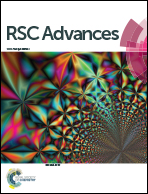Capacitance enhancement by electrochemically active benzene derivatives for graphene-based supercapacitors†
Abstract
Various aromatic molecules have been reported to improve the performance of reduced graphene oxide (rGO)-based supercapacitors. However, the mechanism for this improvement remains unclear. Here we design a facile approach that clearly identifies the main reason for the enhancement. Benzene derivatives, namely p-phenylenediamine (PPD), m-phenylenediamine (MPD), o-phenylenediamine (OPD), hydroquinone (HQ), phenol, aniline and p-aminophenol (PAP) are incorporated into graphene oxide (GO) layers during their reduction and assembly at room temperature. We find that the capacitance increase mainly arises from the pseudocapacitance of specific benzene derivative molecules rather than their spacing effect. Moreover, the para and ortho substituted benzene derivatives contribute much more than the meta substituted ones do. With a small amount of PPD (∼11 wt%), the specific capacitance reaches 273 F g−1, much higher than that of pure rGO electrodes (113 F g−1). The hybrid electrode also shows great stability with a capacitance retention of up to 86% after 10 000 charge/discharge cycles.


 Please wait while we load your content...
Please wait while we load your content...